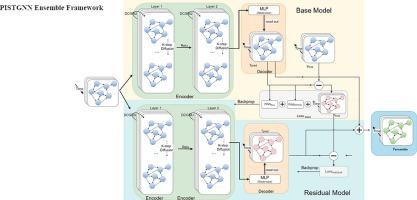Forecasting building operation dynamics using a Physics-Informed Spatio-Temporal Graph Neural Network (PISTGNN) ensemble
IF 6.6
2区 工程技术
Q1 CONSTRUCTION & BUILDING TECHNOLOGY
引用次数: 0
Abstract
Forecasting future building operation states provides operators with comprehensive insights, allowing them to understand and optimize the factors influencing various aspects of building performance, including energy consumption. While conventional modeling tools such as EnergyPlus are widely employed to predict the behavior of buildings, they often struggle to capture the full complexity of real-world operational dynamics, as their outputs are greatly affected by the assumptions made during the modeling process and due to the stochasticity associated with real-world building operations. In this regard, this paper investigates the Physics-Informed Deep Spatio-Temporal Graph Neural Network (PISTGNN) Ensemble, which integrates residual learning and physics constraints into an encoder-decoder structured Diffusion Convolutional Recurrent Neural Network (DCRNN), to precisely estimate building operational dynamics 5 minutes in advance. The experimental results demonstrate that the Ensemble model achieved an average improvement of 44.7% in RMSE over the pure data-driven model across seasonal test sets, underscoring its robustness. Moreover, the model's predictions deviate by only 0.78% from the true values in real-world scenarios, highlighting its exceptional accuracy and reliability for practical applications. PINN integration enhances the model's capability to manage compounding errors in data-sparse regions, reducing model uncertainty.

利用物理信息时空图神经网络(PISTGNN)集成预测建筑运行动态
对未来建筑运行状态的预测为运营商提供了全面的洞察,使他们能够了解和优化影响建筑性能各个方面的因素,包括能耗。虽然EnergyPlus等传统建模工具被广泛用于预测建筑物的行为,但它们往往难以捕捉真实世界操作动态的全部复杂性,因为它们的输出很大程度上受到建模过程中所做假设的影响,并且由于与真实世界建筑操作相关的随机性。在这方面,本文研究了基于物理的深度时空图神经网络(PISTGNN)集成,该集成将残差学习和物理约束集成到编码器-解码器结构的扩散卷积递归神经网络(DCRNN)中,以提前5分钟精确估计建筑物的运行动态。实验结果表明,在季节测试集上,集成模型比纯数据驱动模型的RMSE平均提高了44.7%,突出了其鲁棒性。此外,该模型的预测与现实世界中真实值的偏差仅为0.78%,突出了其在实际应用中的卓越准确性和可靠性。PINN集成增强了模型在数据稀疏区域管理复合误差的能力,降低了模型的不确定性。
本文章由计算机程序翻译,如有差异,请以英文原文为准。
求助全文
约1分钟内获得全文
求助全文
来源期刊

Energy and Buildings
工程技术-工程:土木
CiteScore
12.70
自引率
11.90%
发文量
863
审稿时长
38 days
期刊介绍:
An international journal devoted to investigations of energy use and efficiency in buildings
Energy and Buildings is an international journal publishing articles with explicit links to energy use in buildings. The aim is to present new research results, and new proven practice aimed at reducing the energy needs of a building and improving indoor environment quality.
 求助内容:
求助内容: 应助结果提醒方式:
应助结果提醒方式:


